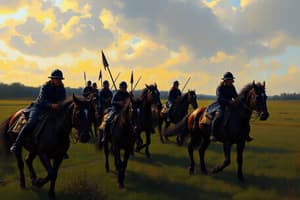Podcast
Questions and Answers
Які три фази можна виділити у процесі трансформації соціальної структури та правового статусу українців у складі Польсько-Литовської Королівщини?
Які три фази можна виділити у процесі трансформації соціальної структури та правового статусу українців у складі Польсько-Литовської Королівщини?
- До-Королівщина, входження до королівства, під домінуванням Росії
- До-Московія, польська епоха, російська епоха
- Початковий, проміжний, завершальний
- Під московським впливом, включення до Польсько-Литовської держави, формування національної ідентичності (correct)
Як українці були представлені політично в Польсько-Литовській Королівщині?
Як українці були представлені політично в Польсько-Литовській Королівщині?
- Через окремих козаків
- Через утриманців королівства
- Через своїх магнатів і духовних лідерів (correct)
- Через окрему політичну одиницю
Що часто підточувало представництво українців в Польсько-Литовському королівстві?
Що часто підточувало представництво українців в Польсько-Литовському королівстві?
- Акцент на колективних інтересах (correct)
- Система шляхетських громад
- Гарантоване змагання
- Система судового стану
Що було характерно для соціальної структури українців у Польсько-Литовському королівстві?
Що було характерно для соціальної структури українців у Польсько-Литовському королівстві?
Як українці представляли свої колективні інтереси в Польсько-Литовському королівстві?
Як українці представляли свої колективні інтереси в Польсько-Литовському королівстві?
Яким чином були представлення українці в Східному Галичині?
Яким чином були представлення українці в Східному Галичині?
Які наслідки мала централізація влади у Речі Посполитій у XVII столітті?
Які наслідки мала централізація влади у Речі Посполитій у XVII столітті?
Що можна сказати про соціальну ієрархію в Україні у цей період?
Що можна сказати про соціальну ієрархію в Україні у цей період?
Куди переважна більшість селян продовжувала працювати у цей період?
Куди переважна більшість селян продовжувала працювати у цей період?
Що спричинило зміни в соціальному устрої України у XVII столітті?
Що спричинило зміни в соціальному устрої України у XVII столітті?
Яке поняття означало посаду гетьмана в Українському козацькому війську?
Яке поняття означало посаду гетьмана в Українському козацькому війську?
Чому багато українців мали обмежені можливості для покращення свого становища у суспільстві Речі Посполитої?
Чому багато українців мали обмежені можливості для покращення свого становища у суспільстві Речі Посполитої?
Study Notes
Transforming Social Structure and Legal Status of the Ukrainian Nation Within the Polish-Lithuanian Commonwealth
The period when Ukraine was part of the Polish-Lithuanian Commonwealth spanned over two centuries from around 1569 until 1795. During this time, significant changes occurred in the social structure and legal status of Ukrainians living under the rule of the Commonwealth. This transformation can broadly be divided into three phases: pre-Commonwealth under Muscovite influence; incorporation into the Polish-Lithuanian state; and emergence of national identity during the late eighteenth century under Russian domination. Here we will focus on the second phase—the incorporation into the Polish-Lithuanian state.
Political Representation
Ukrainians initially did not have a separate political unit within the Commonwealth. They were represented through their respective magnates who held lands within the territory. In some regions, particularly Eastern Galicia, there was also representation by religious leaders such as Orthodox bishops. However, these representations were often undermined by the commonwealth's socio-political system which emphasized personal freedom and individual rights rather than collective interests or group identities.
As the seventeenth century progressed, some nobles began advocating for more power for the Sejm, the parliament of the Commonwealth, which could potentially lead to increased recognition of regional concerns, including those related to the Ukrainians. However, this shift towards centralization of power ultimately weakened the commonwealth, leading to its decline and eventual dissolution.
Social Class Dynamics
During this period, the social hierarchy of Ukraine shifted significantly due to various factors including the growth of merchant classes, development of new professions, and economic migration to Western Europe. Urban centers like Lviv and Kamyanets-Podilskyi emerged as cultural hubs attracting diverse populations from across the region. These areas followed European models of urban life, while rural areas remained largely untouched by these trends.
In terms of land ownership, the majority of peasants continued to work as serfs on noble estates owned by Polish and Lithuanian lords, with only a small percentage enjoying personal freedom. Over time, however, some Ukrainian servitors gained productive status - they became eligible for election to the office of hetman, or senior military commander for Ukraine, which allowed them to wield considerable power.
Despite these shifts, the overall structure of society within the commonwealth maintained a rigid stratification based on birthright, making upward mobility difficult for most members of lower classes regardless of their origins. This limited opportunities for many Ukrainians to advance beyond the roles assigned to them based on societal expectations.
In conclusion, the incorporation of Ukraine into the Polish-Lithuanian Commonwealth led to complex transformations in its social structure and legal status. While it introduced certain protections against arbitrary actions by the monarch, it failed to address deeper problems of feudalism and serfdom that plagued both Poland and Ukraine throughout much of this era. As a result, political representation remained limited and social hierarchies remained entrenched, contributing to the gradual disintegration of the commonwealth itself.
Studying That Suits You
Use AI to generate personalized quizzes and flashcards to suit your learning preferences.
Description
Explore the transformations in social structure and legal status of Ukrainians during their incorporation into the Polish-Lithuanian state from 1569 to 1795. Learn about the political representation and social class dynamics that shaped this period.




